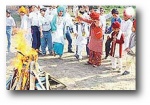Lohri: Difference between revisions
Allenwalla (talk | contribs) m (→Calendar: my typo) |
Allenwalla (talk | contribs) |
||
| Line 9: | Line 9: | ||
==Traditions of Bonfire== | ==Traditions of Bonfire== | ||
In true spirit of the culture, men and women perform [[Bhangra]] and [[Giddha]], popular Punjabi folk dances, around a bonfire. Enthusiastic children go from house house to gather their 'lohri loot' while singing songs They sing old songs about Dulha Bhatti, a Punjabi version of Robin Hood who robbed the rich to give to the poor. People oblige them generously by giving them money and eatables as offering for the festival. Here one notices a similarity to the Western Halloween when children carry out the same hunt for sweets and treats without the money being added in, again the two added months | In true spirit of the culture, men and women perform [[Bhangra]] and [[Giddha]], popular Punjabi folk dances, around a bonfire. Enthusiastic children go from house house to gather their 'lohri loot' while singing songs They sing old songs about Dulha Bhatti, a Punjabi version of Robin Hood who robbed the rich to give to the poor. People oblige them generously by giving them money and eatables as offering for the festival. Here one notices a similarity to the Western Halloween when children carry out the same hunt for sweets and treats without the money being added in, again the two added months of those pesky Roman Emperors puts that festival back to the end of October. | ||
Late in the evening, people gather around the bonfire and throw sweets ([[gachak]] and [[rewri]]), puffed rice and popcorn (as holy offering) into it and sing folk songs. Lohri is also an auspicious occasion to celebrate a newly born baby’s or a new bride’s arrival in the family when gifts, clothes and even money are showered on the mother while her hands are often painted with ‘mehndi’. The day ends with a traditional feast of [[sarson da saag]] and [[makki di roti]] and a dessert of [[rau di kheer]] (a dessert made of sugarcane juice and rice). | Late in the evening, people gather around the bonfire and throw sweets ([[gachak]] and [[rewri]]), puffed rice and popcorn (as holy offering) into it and sing folk songs. Lohri is also an auspicious occasion to celebrate a newly born baby’s or a new bride’s arrival in the family when gifts, clothes and even money are showered on the mother while her hands are often painted with ‘mehndi’. The day ends with a traditional feast of [[sarson da saag]] and [[makki di roti]] and a dessert of [[rau di kheer]] (a dessert made of sugarcane juice and rice). | ||
Revision as of 04:50, 18 January 2008
Lohri
Lohri a festival celebrated on the 13th day of January is a festival of zeal and verve marking the coming culmination of the chilly winter. A time when the sun heads back to the North and stays longer warming the ground for the new crops soon to be sown. The festival is celebrated all over the Panjab, Jammu and Kashmir and even in much of India.
Calendar
The festival shares much in common with festivals all over the world which until Julius Ceasar and his follower Augustus decided that each deserved a month named after them, added two months forever throwing things out of season in the west. This is why September, October, November and December are each 2 months out of sequence with their names derived from Sanskrit. December (10) Das-ember becomes the 12th month. Otherwise the whole world would celebrate the coming of the new year at the same time.
Traditions of Bonfire
In true spirit of the culture, men and women perform Bhangra and Giddha, popular Punjabi folk dances, around a bonfire. Enthusiastic children go from house house to gather their 'lohri loot' while singing songs They sing old songs about Dulha Bhatti, a Punjabi version of Robin Hood who robbed the rich to give to the poor. People oblige them generously by giving them money and eatables as offering for the festival. Here one notices a similarity to the Western Halloween when children carry out the same hunt for sweets and treats without the money being added in, again the two added months of those pesky Roman Emperors puts that festival back to the end of October.
Late in the evening, people gather around the bonfire and throw sweets (gachak and rewri), puffed rice and popcorn (as holy offering) into it and sing folk songs. Lohri is also an auspicious occasion to celebrate a newly born baby’s or a new bride’s arrival in the family when gifts, clothes and even money are showered on the mother while her hands are often painted with ‘mehndi’. The day ends with a traditional feast of sarson da saag and makki di roti and a dessert of rau di kheer (a dessert made of sugarcane juice and rice).
Celebration
Legends
1. It is believed that a king of Rajput tribe , Dula Bhatti had revolt against the Mughal King and was killed.Since then the tribal singers traced the history of Dula Bhatti on Lohri Festival.
2. Lohri and Holika were two sisters. It is said that Harna Kayshap ordered Holika to sit in the fire taking Prahlad in her lap along with Lohri. Prahlad escaped with Lohri whereas Holika expired.
Please help expand this article.

